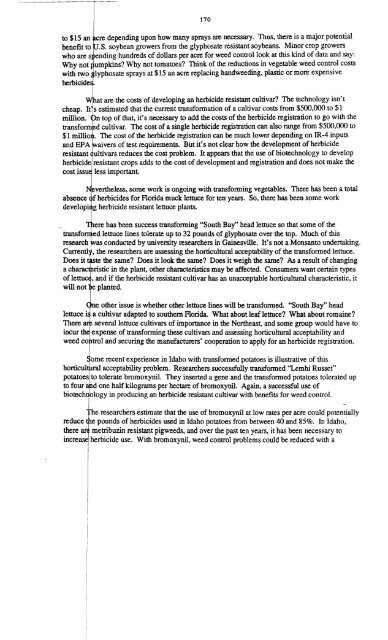Vol. 51â1997 - NorthEastern Weed Science Society
Vol. 51â1997 - NorthEastern Weed Science Society
Vol. 51â1997 - NorthEastern Weed Science Society
You also want an ePaper? Increase the reach of your titles
YUMPU automatically turns print PDFs into web optimized ePapers that Google loves.
170<br />
to $15 an ere depending upon how many sprays are necessary. Thus, there is a major potential<br />
benefit to .S. soybean growers from the glyphosateresistant soybeans. Minor crop growers<br />
who are s nding hundreds of dollars per acre for weed control look at this kind of data and say:<br />
umpkins? Why not tomatoes? Think of the reductionsin vegetable weed control costs<br />
yphosate sprays at $15 an acre replacinghandweeding,plastic or more expensive<br />
t are the costs of developingan herbicideresistantcultivar? The technology isn't<br />
cheap. It s estimated that the current transformationof a cultivar costs from $500,000 to $1<br />
million. top of that, it's necessary to add the costs of the herbicideregistration to go with the<br />
transform d cultivar. The cost of a single herbicideregistrationcan also range from $500,000 to<br />
$1 millio The cost of the herbicideregistrationcan be much lower depending on IR-4 inputs<br />
and EPA aivers of test requirements. But it's not clear how the developmentof herbicide<br />
resistant ultivars reduces the cost problem. It appearsthat the use of biotechnology to develop<br />
herbicide resistant crops adds to the cost of developmentand registrationand does not make the<br />
cost issu less important<br />
vertheless, some work is ongoing with transformingvegetables. There has been a total<br />
f herbicides for Florida muck lettuce for ten years. So, there has been some work<br />
g herbicide resistant lettuce plants.<br />
ere has been success transforming"South Bay" head lettuce so that some of the<br />
ed lettuce lines tolerate up to 32 pounds of glyphosateover the top. Much of this<br />
research as conducted by universityresearchersin Gainesville. It's not a Monsanto undertaking.<br />
Currentl ,the researchers are assessingthe horticulturalacceptabilityof the transformed lettuce.<br />
Does it te the same? Does it look the same? Does it weigh the same? As a result of changing<br />
a charac ristic in the plant, other characteristicsmay be affected. Consumerswant certain types<br />
of lettu ,and if the herbicide resistantcultivar has an unacceptablehorticulturalcharacteristic,it<br />
will not planted.<br />
e other issue is whether other lettuce lines will be transformed. "South Bay" head<br />
a cultivar adapted to southern Florida. What about leaf lettuce? What about romaine?<br />
several lettuce cultivars of importancein the Northeast,and some group would have to<br />
incur th expense of transformingthese cultivarsand assessinghorticulturalacceptabilityand<br />
weed co trol and securing the manufacturers' cooperationto apply for an herbicide registration.<br />
orne recent experience in Idaho with transformedpotatoesis illustrativeof this<br />
horticul acceptabilityproblem. Researcherssuccessfullytransformed"Lemhi Russet"<br />
potatoes to tolerate bromoxynil. They inserted a gene and the transformedpotatoes tolerated up<br />
to four d one half kilograms per hectare of bromoxynil. Again, a successfuluse of<br />
biotee ology in producing an herbicideresistantcultivar with benefitsfor weed control.<br />
mere<br />
e researchers estimate that the use of bromoxynilat low rates per acre could potentially<br />
e pounds of herbicides used in Idaho potatoes from between 40 and 85%. In Idaho,<br />
metribuzin resistant pigweeds,and over the past ten years, it has been necessary to<br />
herbicide use. With bromoxynil,weed control problemscould be reduced with a
















